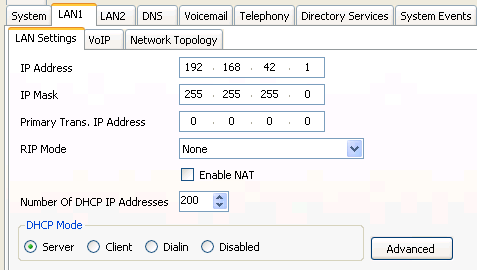Support for SIP extensions is enabled by default. However, it is important to be aware of and check the settings used. The system has two LAN interfaces, LAN1 and LAN2. These match the LAN and WAN ports respectively on the back of the IP500 and IP500v2 control units. LAN1, LAN2 or both can be used to support SIP phones including 1100/1200 Series phones.
1.Using IP Office Manager, retrieve the configuration from the system.
2.Select System.
3.Select the LAN1 or LAN2 tab depending on which of the system's LAN interfaces you want to use to support SIP extensions.

a.Note the IP Address settings for the LAN. These will be used as the file provisioning address for the 1100/1200 SIP phones.
b.If the system is going to be used as the DHCP server for the SIP phones, check that the DHCP settings are enabled and the DHCP pool supports sufficient addresses.
•Installation of 1100 Series and 1200 Series phones using DHCP is only supported if using the system as the DHCP server. The system's Apply to Avaya IP Phones Only option should not be used.
4.Select the VoIP sub-tab.
•SIP Registrar Enable
Check that SIP Registrar Enable is selected.
•Domain Name: Default = Blank
This is the local SIP registrar domain name that will be needed by SIP devices in order to register with the IP Office. If this field is left blank, registration is against the LAN IP address. The examples in this documentation all use registration against the LAN IP address.
•Layer 4 Protocol: Default = Both TCP & UDP
The transport protocol for SIP traffic between the IP Office and SIP extension devices. UDP and TCP are enabled by default. TLS can be enabled if required.
•TCP Port: Default = 5060
The SIP port if using TCP. The default is 5060.
•UDP Port: Default = 5060
The SIP port if using UDP. The default is 5060.
•TLS Port: Default = 5061
The SIP port if using TLS. The default is 5061.
•Challenge Expiry Time (sec): Default = 10
The challenge expiry time is used during SIP extension registration. When a device registers, the IP Office SIP Registrar will send a challenge back to the device and waits for an appropriate response. If the response is not received within this timeout the registration is failed.
5.If you have made any changes, click OK and save the configuration back to the system.
